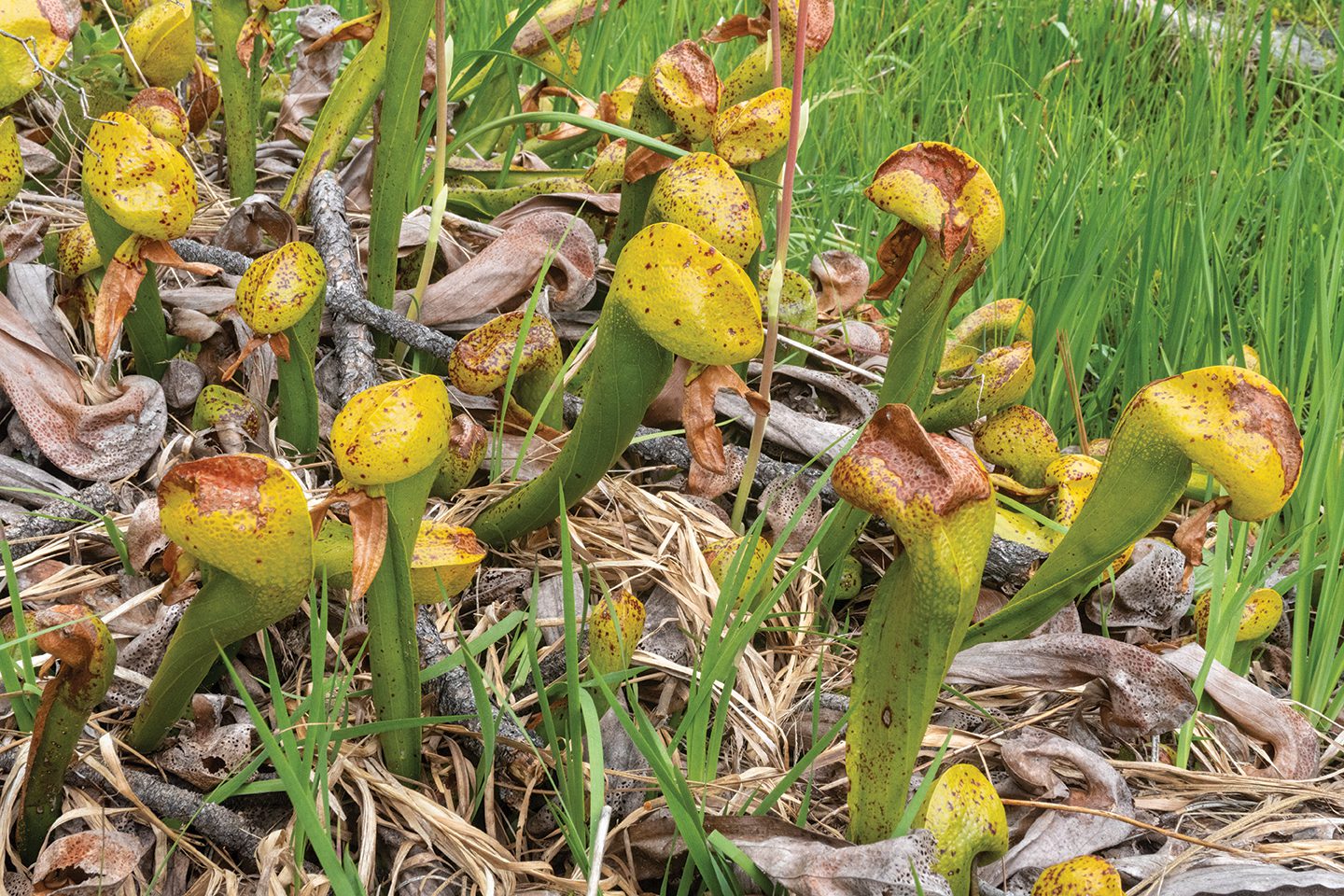
27 Jun California’s Killer Plants
The Sierra Nevada is home to numerous species of carnivorous plants, many of which can be found in the forested wetlands of the Tahoe region
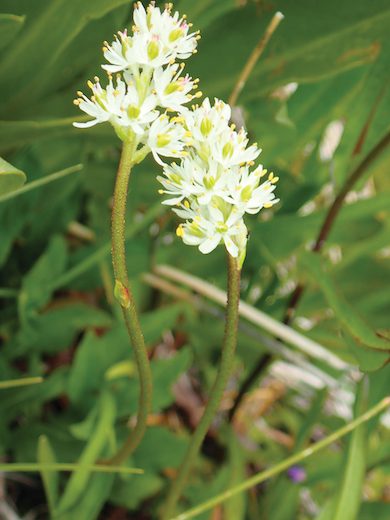
The western false asphodel was only identified as a carnivorous species in 2021, photo by John Brew
Hunger is one of nature’s most potent motivators. Just ask the Donner Party.
But while these starving settlers might be the most famous Sierra residents to seek out “alternative” food sources to survive, they were not the first. Hidden in mosquito-infested wetlands, carnivorous plants of the Sierra found equally creative ways to stay fed long before any stranded pioneers.
Carnivorous plants are fascinating anomalies in the natural world. Unlike most plants that get nourishment from the soil, carnivorous species collect most of their essential nutrients from animals using specially adapted leaf structures to trap, kill and digest insects—or, in some tropical regions, the occasional reptile, bird or rodent. They evolved these murderous adaptations to survive in nutrient-deprived wetland and aquatic habitats.
As strange as it sounds for a plant to kill and eat an animal, carnivory has independently evolved at least a dozen times in the 140 million-plus years flowering plants have been on Earth. Turns out the ability to suck life-giving nutrients from animals is a serious advantage for plants in many unforgiving environments. So much so that over 800 species of carnivorous plants have been identified throughout the world, including every continent except Antarctica.
Many are now cultivated commercially as people grow them in both indoor and outdoor gardens. These days, buying a carnivorous plant is significantly easier than spotting one in the wild, as they are available on Amazon and possibly even your local nursery.
But among U.S. states, California offers more opportunities than most to see carnivorous plants in their natural setting. The state is home to 10 native species, nine of which can be found in the Sierra near Lake Tahoe. They are not easy to locate, however. Observing any of these extraordinary plants in the wild requires seeking out the distinct wetland habitats where they thrive.
Found Only in a Fen
Not all forested wetland areas are created equal. A wetland formed by water from a lake or stream is called a marsh, while a seasonal wetland formed from pooled snowmelt or rainwater is known as a bog. But when a wetland is created by a natural spring or groundwater, it may be a unique wetland habitat described as a fen. Slow-moving groundwater keeps the soil in a fen saturated all year, which limits the decomposition of plant materials. So instead of dirt, the soil in a fen consists of a thick layer of partially decayed organic matter called peat.
Native carnivorous plants such as the sundew, the California pitcher plant and the western false asphodel have evolved over millions of years to grow only in the spongy, carbon-rich peat found in fens. Most fens in the Sierra are less than a half-acre in size, meaning these carnivorous species grow only in small pockets in the forest.
“Fens are these really interesting ecosystems that are usually found in wet meadow areas,” says Mary Meagher, a botanist who works in the Tahoe National Forest. “Because of the soil hydrology, fens are oxygen-deprived habitats, and as a result, the plants have to be a little more evolutionarily creative in the way that they get their nutrients.”
How each species kills and eats its prey is a little different, which is what defines its family and genus.
Captivated by the Cobra Lily
The most well-known carnivorous plant in the world is the Venus flytrap of the genus Dionaea. These plants have a two-lobed leaf that actively snaps shut around an insect mere seconds after the bug walks over it. Venus flytraps are not native to the region though, as they grow wild in only the Carolinas.
The Golden State’s preeminent carnivorous species is the California pitcher plant (Darlingtonia californica), also known as the cobra lily. Despite its aggressive name, the cobra lily takes a more laid-back approach to catching prey than the hypersensitive Venus flytrap. Instead of an active trap, it employs a passive pitfall method.
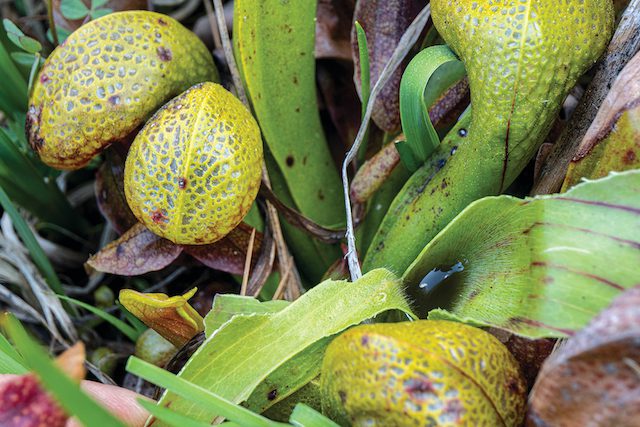
The cobra lily’s tubular leaves hold water and are lined with hairs that prevent a doomed insect’s escape, photo by Seth Lightcap
Like all pitcher plants in the Sarraceniaceae family, the cobra lily has tubular leaves that hold water. They lure insects to crawl into their leaves and fall into the liquid using visual and odorous baiting tactics. Once dead in the water, symbiotic protozoa and bacteria, plus enzymes secreted by the plant, break down the insect’s exoskeleton and free up nutrients in its soft tissues for the plant to absorb.
The cobra lily was first discovered in 1841 near Mount Shasta. Its distinctive hooded leaves resemble a rearing cobra with a forked leaf jutting out below the hood that looks like a serpent’s tongue. Insects are enticed to enter a small hole behind the forked leaf by an intoxicating nectar secreted by the hood. Once inside the tubular leaf, a slippery inner surface and downward-pointing hairs help force the insect into the water and prevent escape.
The cobra lily only grows wild in fen habitats in Southern Oregon and Northern California. They are not easy to come across, but if you see one, you’re likely to see a few, says Meagher.
“Darlingtonia usually grows in these super dense clusters,” she says, “so it’s hard to miss them if you’re lucky enough to find them.”
Stuck on the Sundew
Track down a cobra lily and there’s a good chance you’ll also come across another native carnivorous plant—the innocent-looking but equally deadly sundews of the genus Drosera. Compared to pitcher plants and Venus flytraps, sundews have adapted a slightly simpler, but no less successful, means of capturing prey.
The sundew traps insects with what could be referred to as a “flypaper” method. Its leaves are covered in hair-like glands coated in glistening drops of sticky secretions that look like morning dew. Insects are attracted to the sweet goo, but touching it is a death wish as the surface instantly entraps them.
The plant can sense the insect struggling and, like the Venus flytrap, can immediately bend hairs toward the center of the leaf to prevent escape.
Death occurs through exhaustion or asphyxiation as the goo clogs the insect’s means of absorbing oxygen. Once the bug dies, the sundew secretes enzymes similar to the cobra lily to break it down and absorb the nutrients.
Nearly 200 sundew species are found globally, though only two are native to California—the roundleaf sundew (Drosera rotundifolia) and the English sundew (Drosera anglica). Neither is threatened, but the roundleaf is much more prevalent in the Sierra. Both species are found only in fen habitats.
“The sundews are my favorite carnivorous plant in the Sierra,” says Meagher. “The first thing that will catch your eye when you see them is that they are this beautiful bed of red. Then looking closer you’ll see all the sticky hairs on the leaves with insects caught in them.”
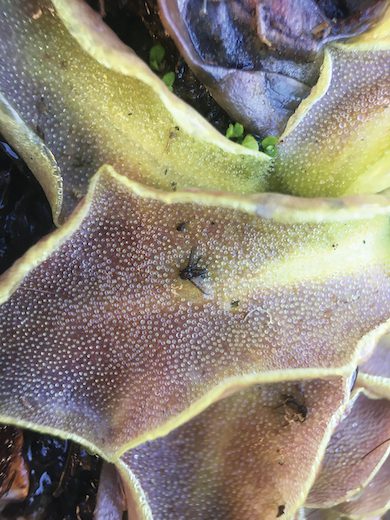
A fly meets its fate in the sticky leaves of a California butterwort, photo by Matt Berger
Equally Gooey and Gruesome
Similar to sundews, two other native California species have evolved plant parts covered in goo to trap hapless bugs on contact.
At first glance, the California butterwort (Pinguicula macroceras) appears as your average wildflower. It has simple, fleshy leaves that form in a rosette pattern and a long, stemmed flower. But upon closer inspection, the butterwort has a deadly trick up its sleeve. Its leaves are covered in droplets of sticky secretions that attract insects in search of water. The wet appearance is all a grisly mirage as the bugs get trapped and killed by the goo. The plant then releases enzymes that break down the insect and free up the nutrients just like the sundew and cobra lily.
Of the roughly 80 butterwort species found globally, Pinguicula macroceras is the only one native to California. It is not found in the Sierra, however. The California butterwort likes moist slopes along creeks and rivers near the Pacific Coast and is more commonly spotted in Oregon than in its namesake state. The best place to see the elusive butterwort in the Golden State is in Del Norte County just south of the Oregon border.
California’s western false asphodel (Triantha occidentalis) also employs the flypaper trap method. But unlike the sundew or butterwort, the false asphodel has a sticky stem as opposed to leaves. The goo it produces is also not as adhesive, so bigger insects like bees and butterflies aren’t trapped as easily. The false asphodel has adapted to catch and digest small gnats and flies, but not the insects that help it pollinate and reproduce.
The plant can be found in wetland areas of the Sierra, as well as along the Pacific Coast from California to Alaska. It also holds the distinction of being one of the most recently identified carnivorous plants in the world. Researchers from the University of British Columbia and University of Wisconsin-Madison discovered the asphodel’s carnivorous behavior in 2021.
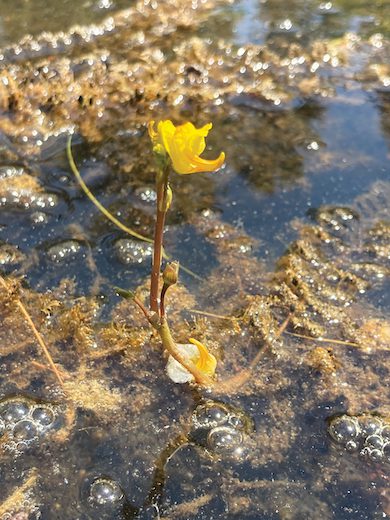
The common bladderwort, which can be found in Lake Tahoe and other lakes throughout the state, traps water bugs to survive, photo by Derek Shiels
The Aquatic Executioner
With more than 225 species, five of which are found in California, the bladderwort (Utricularia) is the world’s most prolific genus of carnivorous plants.
Bladderworts are the only carnivorous plants native to the Sierra that do not grow in fens. Most are fully aquatic plants that live suspended in water. To survive without absorbing any minerals from the soil, they have evolved complex morphology that allows them to trap water bugs, tiny fish and even tadpoles.
What makes bladderworts so unusual is they have a main stem and small flowers, but no roots. Instead, they have heavily segmented stem-like structures that float underwater and support the above-water parts of the plant. Attached to each segment of these underwater stems are round bladder-shaped traps with small openings covered by a lid surrounded by trigger hairs.
When an organism touches one of the hairs, the lid snaps open, creating a pressure differential that sucks the creature into the bladder along with some water. Once the bladder fills with water, the lid snaps closed. The entire process of opening and closing takes a few milliseconds, so an unsuspecting water bug doesn’t stand a chance. Soon enough it is being digested by enzymes secreted by the plant.
The bladderwort’s trapping method is both extremely sophisticated and successful. Reflecting that success, the common bladderwort (Utricularia macrorhiza) is California’s most abundant native carnivorous plant species. It can be found in Lake Tahoe and many other water bodies throughout the state. It’s also the only carnivorous species that grows in Southern California.
The state’s four other bladderwort species—the lesser bladderwort (Utricularia minor), the flat leaf bladderwort (Utricularia intermedia), the humped bladderwort (Utricularia gibba) and the yellowish white bladderwort (Utricularia ochroleuca)—are rarer and only found in select ponds and lakes in Northern California.
The Bountiful Butterfly Valley
Though sundews and bladderworts call the Tahoe Basin home, finding one near Big Blue can be tricky. For a better chance of spotting carnivorous plants in the Sierra, you’ll want to venture north from the Tahoe region.
The valleys just north of Truckee contain more fens than most regions in the Sierra. Keep your eye out for wetland areas near meadows that do not dry up even late in the summer. If you do find a fen, watch your step.
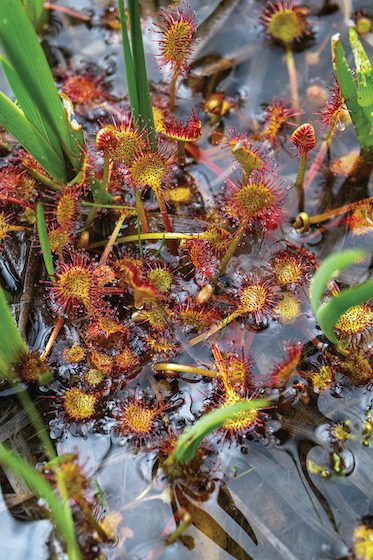
A roundleaf sundew awaits a six-legged meal in the Butterfly Valley Botanical Area, photo by Seth Lightcap
“Fens are very sensitive environments that are very sensitive to getting trampled,” says Meagher. “When someone walks on a fen it exposes the bare peat to oxygen, which increases its decomposition rate and can lead to the deterioration of the fen.”
For those who are game for a longer drive, continuing north another 70 miles from Truckee will provide likely the best opportunity to view carnivorous plants in the entire Sierra. Cobra lilies, sundews and bladderworts can all be found in the Butterfly Valley Botanical Area, a protected wetland in the Plumas National Forest near Quincy.
The Butterfly Valley has been recognized as a remarkably biodiverse botanical area since the 1870s. After a century of intermittent mining, logging and grazing activity, the valley was designated as a protected area in 1976, primarily due to the amazing abundance of California pitcher plants (cobra lilies) found there.
The fen in the Butterfly Valley hosts dense stands of cobra lilies living adjacent to hundreds of roundleaf sundews. Cold water seeps up from the ground in the fen, creating a steady, but slow-moving, flow of water that creates the perfect environment for these two carnivorous species. At the downhill end of the fen is also a small seasonal pond that’s home to two species of bladderworts.
The best time to visit the Butterfly Valley is between May and July when the cobra lilies and other wildflowers are blossoming. Beyond the carnivorous species, the Butterfly Valley is home to a rich diversity of rare plants, including dozens of orchid, lily and fern species.
A 2-mile loop trail with a wooden boardwalk over the fen provides easy access to view the plants without disturbing their habitat. Just don’t forget to bring your mosquito spray, or else the tables will surely turn. Instead of enjoying some peaceful time with a few of California’s most creative carnivores, you’ll be the prey getting eaten alive.
Seth Lightcap is a writer from Olympic Valley who appreciates how carnivorous plants break the rules with humble confidence.




No Comments